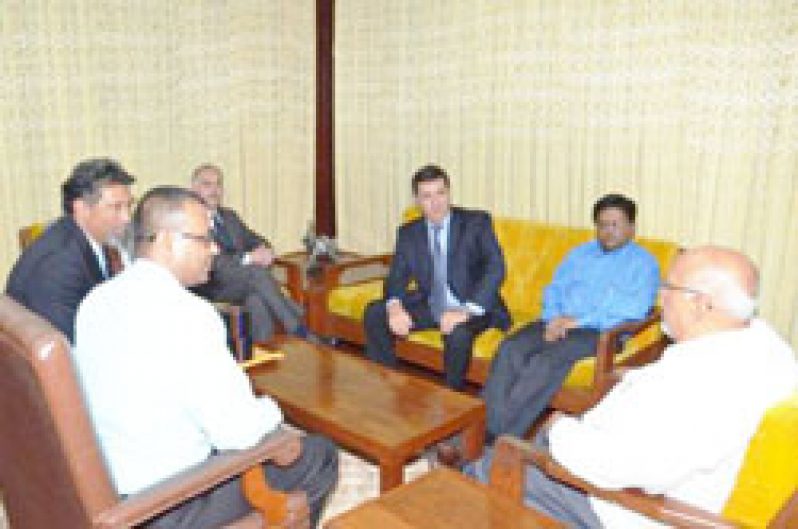A United Nations Economic Commission for Latin America and the Caribbean (ECLAC) report launched on Tuesday, states that Guyana earned US$294M through foreign direct investments (FDI) in 2012, representing a 19 per cent increase from the previous year’s US$247M.
 The Guyana Office for Investment (Go-Invest) reported that total FDI increased by 17.2%, from US$164.4M in 2009 to US$198M in 2010. The agriculture, forestry and fishing sectors benefited from a 12.8% increase in FDI in 2010; the energy sector grew by 36.9%; mining and quarrying by 34.2%; manufacturing by 49.7%, and tourism and hospitality by 21.9%.
The Guyana Office for Investment (Go-Invest) reported that total FDI increased by 17.2%, from US$164.4M in 2009 to US$198M in 2010. The agriculture, forestry and fishing sectors benefited from a 12.8% increase in FDI in 2010; the energy sector grew by 36.9%; mining and quarrying by 34.2%; manufacturing by 49.7%, and tourism and hospitality by 21.9%.
With a deliberate policy position to liberalise the economy, Guyana has enjoyed sustained exchange rate stability, constantly low inflation rates, interest rates that have influenced an exponential increase in commercial lending, a manageable debt to Gross Domestic Product (GDP) ratio, and healthy international reserves.
Seven consecutive years of growth and a prediction by the International Monetary Fund (IMF) of a similar trend for this year and 2014, is and should come as good news for every Guyanese. Growth is predicted by the IMF at 5.5 percent for this year, and six percent for 2014 in an economy that is considered the “shining star of the Caribbean” and has influenced significant private sector growth.
The Government has been highlighting the many achievements that have been made since the People’s Progressive Party Civic (PPP/C) administration took office in 1992, and these have been vindicated by foreigners who have done their analysis of Guyana, particularly in the context of the global environment that is still recovering from an economic crisis.
“Guyana is economically on the rise and of great interest to investors both domestically and internationally…there is little that can match the power and scope of private investment when it comes to innovation, prosperity and security of developing nations such as Guyana,” Canadian High Commissioner David Devine said at the launch of the Invest Guyana magazine on May 9.
Jamaican billionaire, Michael Lee Chin, Portland Holdings Chairman and the National Commercial Bank (NCB) Managing Director Patrick Hylton recently came to Guyana in search of investment opportunities, wooed by the attractive business environment.
“Climate, potential, the fact that the country (Guyana) has a long runway of opportunities ahead of it, given that you are so blessed in all sorts of minerals natural resources…,” were some of the attributes that Lee Chin said have attracted the group to Guyana.
His colleague Hylton added, “When we look at the macro-statistics, we see the stability that has taken place, we see the growth that has taken place, we see where the economy seems to be on a good path… Guyana is one of the countries to which we are attracted”.
INVESTMENT
The Canadian Government is one of several diplomatic partners that have maximised on the opportunities to invest billions of dollars in job creation ventures such as in natural resources exploration.
The search for oil in a basin that was once vastly underexplored has seen reputable petroleum exploration companies CGX, of Canada, Repsol of Spain, and Exxon Mobil of the United Kingdom investing millions. As recent as May 14, Repsol signed another agreement with the Guyana Government to explore for oil in the Takutu block in the Berbice river.
Within the last three years, historic large scale investments by First Bauxite Corporation in bauxite mining at the Bonasika mine along the Essequibo River, Canada’s Guyana Goldfields Inc., at the Aurora Cuyuni River Mines, Sandspring Resources Inc., at Toroparu mines and Reunion Manganese Incorporated in the Matthews Ridge area have been witnessed.
Just three years ago, Minister of Finance Dr. Ashni Singh had said that, grouped together, international investor confidence in Guyana, from the exploration sector amounted to CDN $2B.
Through the Canadian International Development Agency (CIDA) several initiatives that are aimed at fostering investment have been supported in Guyana and the Caribbean.
Guyana has fortunately met most of the requirements to encourage investors with a stable macro-economic environment that has over the last few years seen a stable currency and low inflation, positive relations with neighbouring countries like Venezuela, a major trading partner, and Brazil, a rapidly emerging economy.
There are some factors such as security, the availability of human capital and a highly disciplined workforce, accountability and transparency and the physical environment that influence investors’ decisions.
President Donald Ramotar is however optimistic that Guyana is within reach of expectations, particularly in the area of human capital where emphasis has over the years been placed on improving the education sector in the effort to build a committed work force.
Additionally, with major infrastructure projects in the making like the Amaila Falls Hydropower Project (AFHP), the Cheddi Jagan International Airport (CJIA) expansion project, and the Marriott Hotel, Guyana is on track in transforming towards the new growth poles for development.
The tourism sector for example has seen an influx of visitors and with the CJIA expansion and Specialty Hospital construction plans, Guyana was bracing itself for an unprecedented development in the sector. Unfortunately those investments have been frustrated in the Parliament, with the political opposition cutting the budgetary allocations for these key projects.
Last year, contributions to Gross Domestic Product (GDP) from the tourism sector were estimated at $22.2B by the World Travel and Tourism Council which has also projected a 1.9 percent increase this year.
On the local side, a recent survey of commercial businesses show more than 91 percent enjoyed profits last year, proving once again, the dynamism of the Guyanese economy, and the rewards entrepreneurs have been enjoying.




.jpg)










